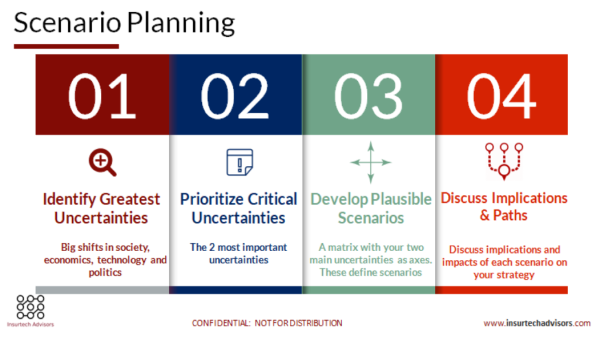Finding opportunities in these trying Covid-19 times
I have been wanting to write something since the beginning of the Coronavirus outbreak, but I knew you were all very busy at work and on the home front. We have 6 kids at home who all have to still be educated and connected with their schools. I’ve become the head of technology support! May you all stay safe in these uncertain times.
Apart from the personal aspect that now is impacting you and your family, there has also been an impact on your business, colleagues, clients, and suppliers. This is something far more significant than the market crash of 2008, or even the hurricanes, tornadoes, and other weather events we have had to endure as people and a nation or you as an insurer.
Our linear ways of dealing with and thinking about risk and operations don’t help when we encounter “black swan” situations where the fundamental drivers of our business are no longer the only drivers of risk or how we operate. For example, we can probably quantify the risk of an asteroid crashing on earth and what its impact will be. Times like now, where the macroeconomic, social, technology and political futures are unknown, we need to be nimble to reduce overall risk and discover new opportunities.
Companies that excel in these environments need an executive team that is aligned around the greatest uncertainties and that can react in a nimble and agile way. Scenarios planning helps the executive team agree on the greatest uncertainties and align on how you should react should they occur (or are occurring).
I know of one carrier that has a Pandemic preparedness plan. However, it was focused on business continuity from the carrier’s point of view. You can even find a FEMA “Pandemic Influenza Continuity Plan Template” which addresses internal issues including social distancing and remote working, but it didn’t address what would happen to your customers, agents, and suppliers, and how that would impact your business.
Last week I heard a person mention that a restaurant had asked him (the landlord) if he could forego rent payments. That got me wondering. What are the additional trickle-down impacts on carriers? Does the restaurant also stop paying their premiums? Does the landlord stop paying premiums? Is the impact universal across all lines of business? What about commercial auto? Will we finally see a year where the economics of the business work? I don’t have the answers to these questions, but I know that addressing them and thinking about them in future scenarios is now more important than ever.
Scenario Planning in a Nutshell
Scenario planning is making assumptions on what the future will be and how your business environment will change over time considering that future.
Scenario planning is about working as a leadership team to identify a specific set of uncertainties. These are nothing more than different “realities” of what might happen in the future for your business (which should include insureds, agents, and suppliers).
While this sounds simple, building this set of assumptions is not always easy. However, it will be the best thing you can ever do to help guide your organization in the long term. It’s also not too late. You should devote some time right now to highlighting and planning for different outcomes.

There are four steps to creating scenarios.
-
Identify your greatest uncertainties:
Some areas you should discuss are what will be the big shifts in society, economics, technology, and politics and see how it might affect your organization. This is the time to list out as many as you can think of and start to group them.
-
Prioritize your critical uncertainties:
Once you have identified your driving forces, pick only two (those that have the most impact on your business). For example, two of the most important uncertainties for manufacturing companies are raw material prices and consumer demand.
-
Develop a range of plausible scenarios:
The goal is to form a matrix with your two critical uncertainties as axes. This now allows you to draw four possible scenarios for the future. These are discussed in the next step.
-
Discuss the implications and possible paths forward:
During this final step, discuss the various implications and impacts of each scenario on your business outcomes. This should then lead to a conversation about your current strategy. Ultimately, you will want to set your mission and your goals while considering every scenario.
Please let me know if you are interested in finding out more about how scenario planning could help you, even in our current environment. If there is enough interest, I will organize a webinar over the next few weeks.
Wishing you, your family, and all those you support a safe and productive week.
#scenarioplanning #insurance #insurtech #covid-19 #coronavirus
Insurtech Advisors is dedicated to helping regional insurance carriers plan for the future today. We help you identify and partner with Insurtechs. This enables you to thrive and continue to meet the needs of your members, employees, and independent agents.

